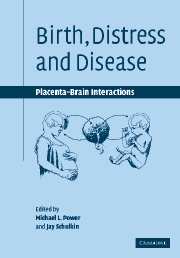Book contents
- Frontmatter
- Contents
- List of contributors
- Preface
- Introduction: brain and placenta, birth and behavior, health and disease
- 1 Placental expression of neurohormones and other neuroactive molecules in human pregnancy
- 2 The regulation of human parturition
- 3 Maternal nutrition and metabolic control of pregnancy
- 4 Fetal HPA activation, preterm birth and postnatal programming
- 5 Prenatal glucocorticoids and the programming of adult disease
- 6 Prenatal stress and stress physiology influences human fetal and infant development
- 7 Glucocorticoids and the ups and downs of neuropeptide gene expression
- 8 Glucocorticoid facilitation of corticotropin-releasing hormone in the placenta and the brain: functional impact on birth and behavior
- Index
7 - Glucocorticoids and the ups and downs of neuropeptide gene expression
Published online by Cambridge University Press: 16 October 2009
- Frontmatter
- Contents
- List of contributors
- Preface
- Introduction: brain and placenta, birth and behavior, health and disease
- 1 Placental expression of neurohormones and other neuroactive molecules in human pregnancy
- 2 The regulation of human parturition
- 3 Maternal nutrition and metabolic control of pregnancy
- 4 Fetal HPA activation, preterm birth and postnatal programming
- 5 Prenatal glucocorticoids and the programming of adult disease
- 6 Prenatal stress and stress physiology influences human fetal and infant development
- 7 Glucocorticoids and the ups and downs of neuropeptide gene expression
- 8 Glucocorticoid facilitation of corticotropin-releasing hormone in the placenta and the brain: functional impact on birth and behavior
- Index
Summary
Introduction
Neuropeptides, such as corticotropin-releasing hormone (CRH) are critical molecules that act as neuromodulators throughout the central nervous system. They are implicated in controlling a wide range of behavioral, autonomic, and neuroendocrine functions. Glucocorticoids are important hormones that have profound effects on many aspects of neuronal function, including the regulation of neuropeptide biosynthesis. Elevated levels of maternal and fetal glucocorticoids play important roles in the normal progression of pregnancy and fetal growth; however, they also have been implicated in many pathologies of pregnancy and fetal development (see Chapters 3–6). Their role in regulating neuropeptides, both in fetal and maternal brain, has been suggested as a causal link in their effects on pregnancy and fetal development.
The proposed effects of glucocorticoids on the maternal—placental—fetal axis are based on epidemiological evidence and experimental manipulations in animal models. The mechanisms by which glucocorticoids regulate neuropeptide storage, release, and gene expression, however, are not completely understood. A clearer understanding of these processes is necessary to generate and test meaningful hypotheses about how these mechanisms are controlled. Recent findings indicate that glucocorticoids have variable effects on CRH regulation depending on cell type, and intra- and extracellular factors.
Perhaps the most familiar example of glucocorticoid actions on neuropeptide gene expression is its inhibitory actions on CRH and arginine vasopressin (AVP) genes in neuroendocrine neurons of the hypothalamic paraventricular nucleus (PVH).
- Type
- Chapter
- Information
- Birth, Distress and DiseasePlacental-Brain Interactions, pp. 202 - 234Publisher: Cambridge University PressPrint publication year: 2005
- 1
- Cited by



